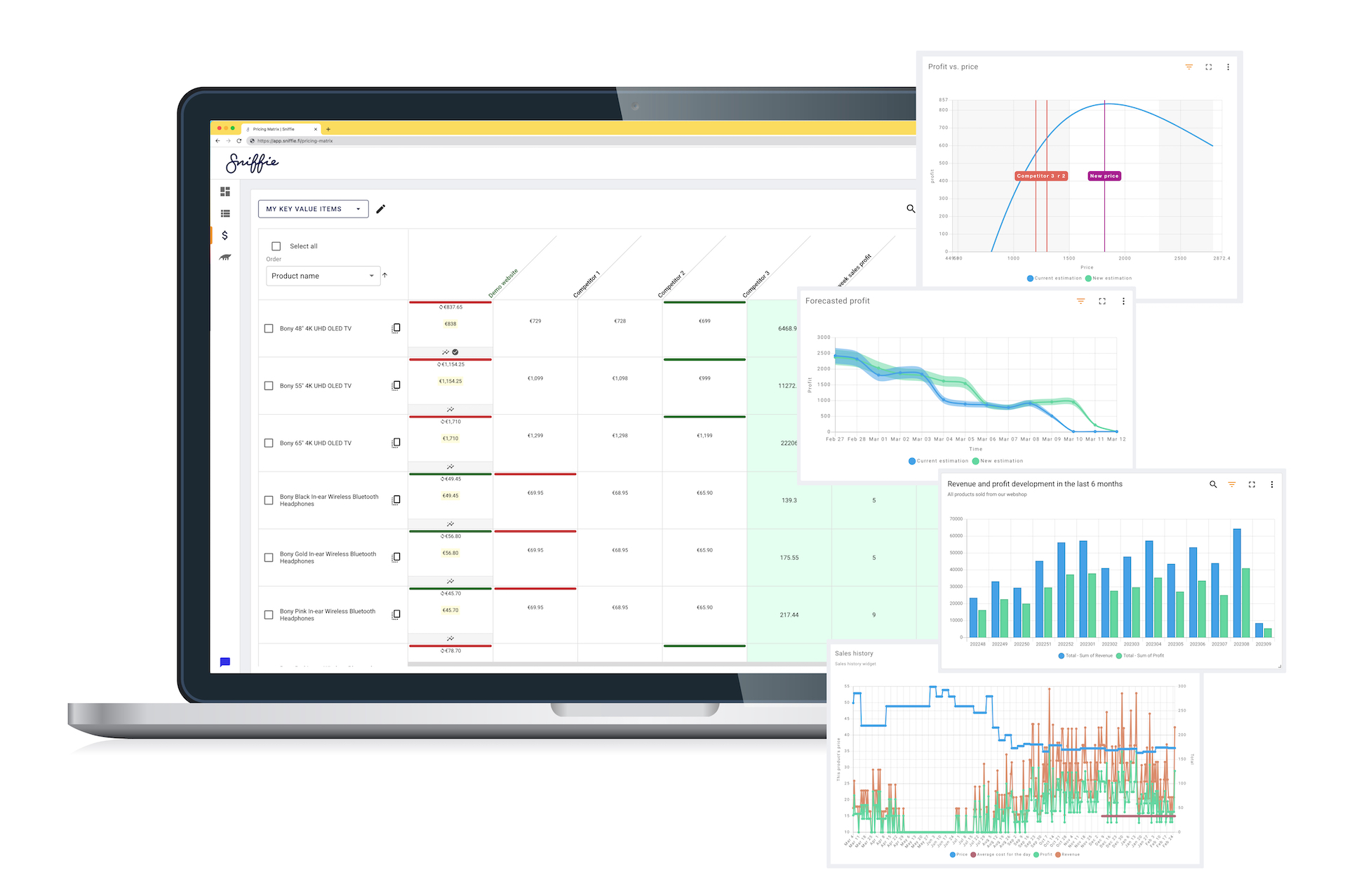Things to remember when pricing electronics
As an electronic store owner, pricing electronics is one of the most critical aspects of your business. With so many competitors in the market, it’s essential to develop pricing strategies that not only attract customers, but also generate revenue.
In this article, we’ll explore how to create pricing strategies for electronics products, how to optimize pricing, and how to make use of pricing software to streamline the process.
Want to try out Sniffie?
Take a spin with our free trial for Shopify to give you a thorough outlook on how we could support you.
Claim your free 14-day trial for Shopify now!
See the power of Sniffie with your own Shopify data. Fill-out the form below to gain access to your demo account within 24 hours.

1 – Analyze your competition
One of the first steps to creating a successful pricing strategy is to analyze your competition. Check the prices of similar products and analyze their pricing strategies. You can use this information to adjust your pricing and differentiate yourself from the competition. Consider offering unique features or bundling products to create value for customers.
2 – Understand your audience
Understanding your target audience is critical when creating pricing strategies. Different audiences have different budgets and preferences, so it’s essential to tailor your offering accordingly. For example, young consumers may be more price-sensitive, while professionals may be willing to pay more for premium products. Research your target audience to determine their preferences and adjust your strategy accordingly.
3 – Consider the product lifecycle
Electronic products typically have a shorter lifecycle than other products. As a result, it’s essential to consider the product lifecycle when developing your pricing strategy. Pricing should be adjusted to reflect the product’s position in the lifecycle. For example, initial pricing for new products should be higher to capitalize on the hype surrounding the product, while for older products it should be lower to attract budget-conscious consumers.
4 – Optimize your pricing strategy
Pricing optimization is a continuous process that involves regularly adjusting prices to reflect market trends and consumer behavior. By optimizing your product prices, you can increase revenue, attract new customers, and improve customer loyalty. Consider using software to automate the pricing optimization process. Pricing software can analyze sales data and consumer behavior to identify pricing trends and adjust prices automatically.
Let’s say you run an electronics store, and you’re interested in optimizing the pricing for your products, including phones, smartwatches, and computers. Here are a few examples of how you might apply pricing optimization strategies to these products:
- Analyzing Sales Data: By looking at sales data, you can identify which products are the most popular, which products have the highest profit margins, and which products may be underperforming. For example, if you notice that a particular model of phone is consistently selling out, you may want to consider raising the price slightly to take advantage of the high demand. On the other hand, if you have a slow-moving product, you may want to lower the price to attract more buyers.
- Consumer Behavior Analysis: You can use pricing software to analyze consumer behavior and identify price trends. For example, if you notice that customers tend to purchase phones with larger screens or more memory, you may want to adjust the prices of those models accordingly to reflect their higher value to customers.
- Dynamic Pricing: Another strategy you can use is dynamic pricing, which involves adjusting prices in real time based on changes in supply and demand. For example, if a new model of phone is released and demand for the previous model drops, you can use dynamic pricing to lower the price of the older model to attract buyers and move inventory.
Pricing software is a valuable tool for electronic store owners. By automating the pricing process, the software can save time and resources while providing valuable insights into pricing trends and consumer behavior. Consider using pricing software to analyze market trends, conduct competitor analysis, and optimize pricing. Look for software that is specifically designed for electronics products and that offers features like data analytics, dynamic pricing algorithms, and competitor analysis.
Conclusion
In conclusion, pricing electronics and creating pricing strategies for electronic products requires careful analysis of the market, target audience, and product lifecycle. By carefully pricing electronics and optimizing pricing, store owners can increase revenue, attract new customers, and improve customer loyalty. Pricing software can be a valuable tool for streamlining the process of pricing electronics and providing valuable insights into pricing trends and consumer behavior. By following these tips, electronic store owners can develop pricing strategies that generate revenue and keep their businesses competitive.
FAQ
- What specific methods or tools can electronic store owners utilize to analyze consumer behavior and preferences within their target audience to tailor pricing strategies accordingly?
- These methods may include conducting surveys or focus groups to gather direct feedback from customers, analyzing sales data to identify purchasing patterns and trends, and using customer relationship management (CRM) software to track individual customer interactions and preferences over time. Additionally, leveraging data analytics tools and market research reports can provide insights into broader consumer trends and preferences within the electronics industry.


